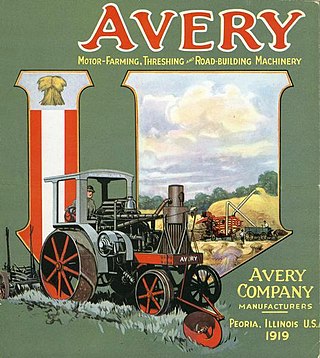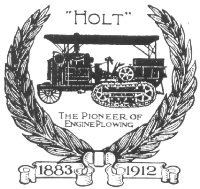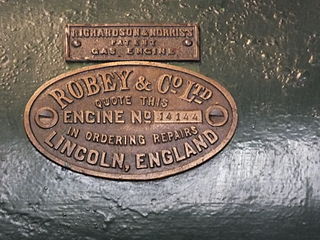

Russell & Company of Massillon, Ohio, are best known for manufacturing farm and railroad machinery in the late 19th and early 20th centuries. Most notably 18,000 Steam tractors and Stationary engines, plus 22,000 Threshing machines. [1] [2] [3]


Russell & Company of Massillon, Ohio, are best known for manufacturing farm and railroad machinery in the late 19th and early 20th centuries. Most notably 18,000 Steam tractors and Stationary engines, plus 22,000 Threshing machines. [1] [2] [3]



In 1838 Nahum and Clement Russell started a general carpentry business in Massillon, Ohio. They used a two-story frame building, and drove the machinery by horse-power. They made ploughs (plows) and agricultural implements, plus building houses, furniture, coffins, and more. The carpentry shop burned down in 1840.
Charles M, Nahum and Clement – formed C.M. Russell & Co. on Jan. 1, 1842, based in an old whitewashed building called the "White Shop". [1] [3] On seeing Hiram and John Pitts' Buffalo Pitts Separator (Thresher) they understood its short-comings such that their improved version took the honours at the Ohio State Fair at Columbus in 1845. [4] [3] [5]
The Russells purchased stock in the Ohio & Pennsylvania Railroad, urged it to come through Massillon, and in 1852 they began producing handcars and stock cars for the railroad company. The business flourished, three more brothers joined and in 1864 it was incorporated as "Russell & Co". [3] [5]
In 1871 the company divided; C. Russell & Co. moved to Canton, Ohio to make agricultural reapers and mowers. [3] [5]
On May 17, 1878, a fire did $150,000 of damage to machinery, wagon stock and 36 years of patterns. Insurance covered only $53,100, a third of the total. Two-thirds of the main building was saved and new machinery was ordered, but 250 men were 'out of work'. A new 250 foot long four-story brick warehouse was built. [3]
Russell & Co reportedly started building Steam Traction Engines after their 1878 incorporation, and by 1880, they employed 425 people on a seven acre site, with their own railroad sidetrack. [3]
By 1884, they had become one of the largest producers of steam traction engines, plus building industrial, railroad and agricultural equipment. [2]
By 1909, the 21 acre plant had produced 18,000 farm, traction and stationary engines, plus 22,000 threshing machines. They also made sawmills, pneumatic stackers, feeders and road rollers. [3]
By 1912, the company was in decline, and it merged with "Griscom-Spencer" Company of New Jersey. They created parts for Naval vessels during World War I, and earned an Army-Navy “E” for excellence during World War II. [1]
In 1962, the company was purchased by Baldwin-Lima-Hamilton Company and the Massillon plant closed, laying off 800 employees). [1]




Russell steam traction engines ranged from 6 HP to 150 HP.
The first Russell steam roller was introduced about 1910, as a combination of a road roller and a hauling engine. The detachable rear wheel cleats enabled rolling use. [3]
The 1901 catalogue offered static engines for factory /machine shop work. Listed as 4-Valve Automatic Engines.

A threshing machine or a thresher is a piece of farm equipment that separates grain seed from the stalks and husks. It does so by beating the plant to make the seeds fall out. Before such machines were developed, threshing was done by hand with flails: such hand threshing was very laborious and time-consuming, taking about one-quarter of agricultural labour by the 18th century. Mechanization of this process removed a substantial amount of drudgery from farm labour. The first threshing machine was invented circa 1786 by the Scottish engineer Andrew Meikle, and the subsequent adoption of such machines was one of the earlier examples of the mechanization of agriculture. During the 19th century, threshers and mechanical reapers and reaper-binders gradually became widespread and made grain production much less laborious.

The modern combine harvester, or simply combine, is a machine designed to harvest a variety of grain crops. The name derives from its combining four separate harvesting operations—reaping, threshing, gathering, and winnowing—to a single process. Among the crops harvested with a combine are wheat, rice, oats, rye, barley, corn (maize), sorghum, millet, soybeans, flax (linseed), sunflowers and rapeseed. The separated straw, left lying on the field, comprises the stems and any remaining leaves of the crop with limited nutrients left in it: the straw is then either chopped, spread on the field and ploughed back in or baled for bedding and limited-feed for livestock.

A traction engine is a steam-powered tractor used to move heavy loads on roads, plough ground or to provide power at a chosen location. The name derives from the Latin tractus, meaning 'drawn', since the prime function of any traction engine is to draw a load behind it. They are sometimes called road locomotives to distinguish them from railway locomotives – that is, steam engines that run on rails.

Marshall, Sons & Co. was a British agricultural machinery manufacturer founded in 1848. The company was based in the Britannia Iron Works, Gainsborough, Lincolnshire. Early production was of steam engines and agricultural machinery. Later production included diesel tractors such as the Field Marshall, Track Marshall and former Leyland wheeled tractors.

Live steam is steam under pressure, obtained by heating water in a boiler. The steam may be used to operate stationary or moving equipment.

The Case Corporation was a manufacturer of agricultural machinery and construction equipment. Founded, in 1842, by Jerome Increase Case as the J. I. Case Threshing Machine Company, it operated under that name for most of a century. For another 66 years it was the J. I. Case Company, and was often called simply Case. In the late 19th century, Case was one of America's largest builders of steam engines, producing self-propelled portable engines, traction engines and steam tractors. It was a major producer of threshing machines and other harvesting equipment. The company also produced various machinery for the U.S. military. In the 20th century, Case was among the ten largest builders of farm tractors for many years. In the 1950s its construction equipment line became its primary focus, with agricultural business second.
The Rough and Tumble Engineers Historical Association puts on the second- or third-oldest Threshermen’s Reunion in the United States. It is held in the middle of August each year, from Wednesday through Saturday, in Kinzers, Pennsylvania, about eight miles east of the city of Lancaster. The association’s name is taken from the 1890s book Rough and Tumble Engineering: Book of Instructions for Operators of Farm and Traction Engines by James H. Maggard.

The Advance-Rumely Company of La Porte, Indiana was an American pioneering producer of many types of agricultural machinery, most notably threshing machines and large tractors. Started in 1853 manufacturing threshers and later moved on to steam engines. Allis-Chalmers Manufacturing Co. purchased Advance-Rumley in 1931. The company's main works would become what was later known as the "La Porte plant".

The Avery Company, founded by Robert Hanneman Avery, was an American farm tractor manufacturer famed for its undermounted engine which resembled a railroad engine more than a conventional farm steam engine. Avery founded the farm implement business after the Civil War. His company built a large line of products, including steam engines, beginning in 1891. The company started with a return flue design and later adapted the undermount style, including a bulldog design on the smokebox door. Their design was well received by farmers in central Illinois. They expanded their market nationwide and overseas until the 1920s, when they failed to innovate and the company faltered. They manufactured trucks for a period of time, and then automobiles. until they finally succumbed to an agricultural crisis and the Depression.

A portable engine is an engine, either a steam engine or an internal combustion engine, that sits in one place while operating, but is portable and thus can be easily moved from one work site to another. Mounted on wheels or skids, it is either towed to the work site or moves there via self-propulsion.

Daniel Best was an American adventurer, businessman, farmer, and inventor known for pioneering agriculture machinery and heavy machinery.

Gaar, Scott & Co., was an American threshing machine and steam traction engine builder founded in 1849 and based in Richmond, Indiana. The company built simple and compound engines in sizes from 10 to 50 horsepower. Farm machinery produced by the firm were advertised as part of "the Tiger Line" and used a tiger upon two globes as the company logo. In the Fall of 1869, A. Gaar & Co. won "Best Portable Farm Steam Engine" and "Best Eight Horse Power" at the 17th Illinois State Fair, for which it won two Silver Medal prizes. It merged with the M. Rumley Co. in 1911 during a purchasing frenzy that put the later firm into insolvency. The company was reorganized as Advance-Rumely Thresher Company Inc. Advance-Rumely Thresher Company was later purchased by Allis-Chalmers Mfg. Co.

Clayton & Shuttleworth was an engineering company located at Stamp End Works, Lincoln, Lincolnshire, England. The company was established in 1842 when Nathaniel Clayton (1811–1890) formed a partnership with his brother-in-law, Joseph Shuttleworth (1819–83).

The Oliver Farm Equipment Company was an American farm equipment manufacturer from the 20th century. It was formed as a result of a 1929 merger of four companies: the American Seeding Machine Company of Richmond, Indiana; Oliver Chilled Plow Works of South Bend, Indiana; Hart-Parr Tractor Company of Charles City, Iowa; and Nichols and Shepard Company of Battle Creek, Michigan.

The Holt Manufacturing Company began with the 1883 founding of Stockton Wheel Service in Stockton, California, United States. Benjamin Holt, later credited with patenting the first workable crawler ("caterpillar") tractor design, incorporated the Holt Manufacturing Company in 1892. Holt Manufacturing Company was the first company to successfully manufacture a continuous track tractor By the early 20th century, Holt Manufacturing Company was the leading manufacturer of combine harvesters in the US, and the leading California-based manufacturer of steam traction engines.

Agricultural machinery relates to the mechanical structures and devices used in farming or other agriculture. There are many types of such equipment, from hand tools and power tools to tractors and the countless kinds of farm implements that they tow or operate. Diverse arrays of equipment are used in both organic and nonorganic farming. Especially since the advent of mechanised agriculture, agricultural machinery is an indispensable part of how the world is fed. Agricultural machinery can be regarded as part of wider agricultural automation technologies, which includes the more advanced digital equipment and robotics. While agricultural robots have the potential to automate the three key steps involved in any agricultural operation, conventional motorized machinery is used principally to automate only the performing step where diagnosis and decision-making are conducted by humans based on observations and experience.
The National Threshers Association (NTA) is a non-profit group of enthusiasts who are interested in steam-powered traction engines - also known as "steam tractors", "steam traction engines" or simply "steam engines" - as well as related equipment. The group's premier event is its annual reunion/show, which features live exhibits of antique steam engines and gas-powered machinery from throughout the United States and Canada. Dating back to 1944, the annual show is recognized as the oldest event of its type in the United States.

Robey and Co. was an engineering company based in Lincoln, Lincolnshire, England which can be traced back to around 1849.
{{cite web}}: CS1 maint: unfit URL (link)